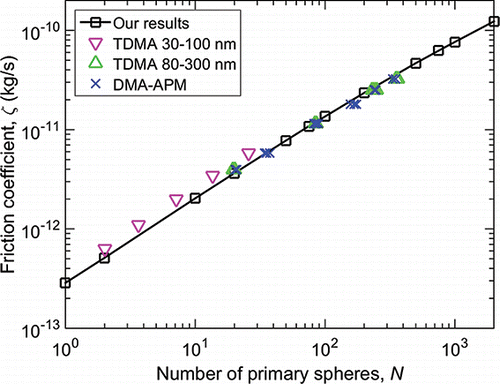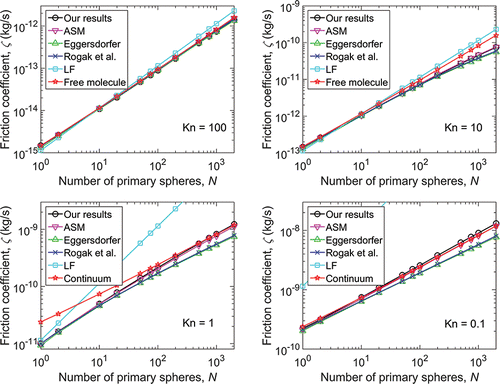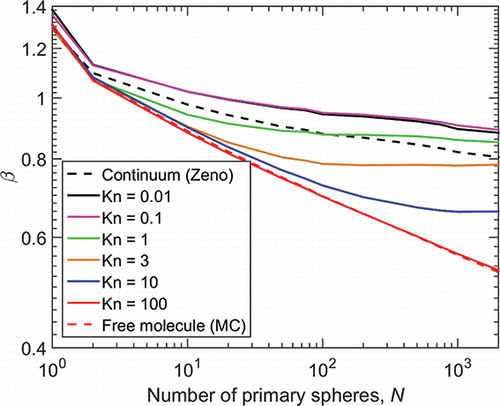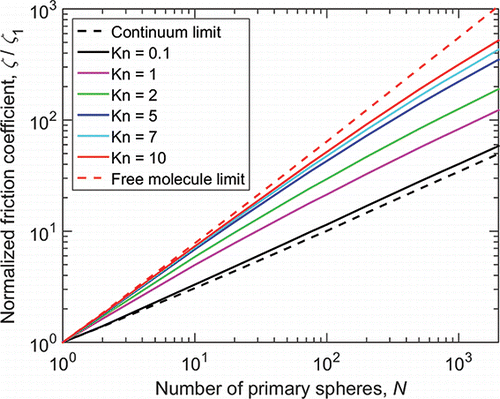Figures & data
Figure 1. Friction factor results for fractal aggregates with primary sphere diameter 19.5 nm in ambient air (Kn = 7). TDMA and DMA-APM results (Shin et al. Citation2009, Citation2010) are shown for comparison.

Figure 2. Comparison of self-consistent field results to other models for the scalar friction factor for (a) Kn = 100, (b) Kn = 10, (c) Kn = 1, and (d) Kn = 0.1. Results are for particles in ambient air. Where appropriate, free molecular results from a ballistic algorithm and continuum results from the Zeno code are displayed for reference.

Figure 3. Ratio of friction coefficients from other models to our results for N = 2000. Free molecule and continuum results are calculated using our own Monte Carlo algorithm and the Zeno algorithm, respectively. For the upper plot, our friction coefficient results are obtained using the calculated drag from the BGK model. For the lower plot, our friction coefficient results use the Cunningham slip formula for the monomer friction coefficient ( in Equation (Equation18
[18] )). Free molecule results for Kn < 15, LF results for Kn < 35, and continuum results for Kn > 15 are more than twice our self-consistent field results and thus do not appear in the plots above.
![Figure 3. Ratio of friction coefficients from other models to our results for N = 2000. Free molecule and continuum results are calculated using our own Monte Carlo algorithm and the Zeno algorithm, respectively. For the upper plot, our friction coefficient results are obtained using the calculated drag from the BGK model. For the lower plot, our friction coefficient results use the Cunningham slip formula for the monomer friction coefficient ( in Equation (Equation18[18] )). Free molecule results for Kn < 15, LF results for Kn < 35, and continuum results for Kn > 15 are more than twice our self-consistent field results and thus do not appear in the plots above.](/cms/asset/c69e3856-571c-4037-b93d-34a5e0fed1e0/uast_a_1300635_f0003_oc.gif)
Figure 5. Relationship between the mobility radius and the radius of gyration for several Knudsen numbers.

Figure 6. Normalized friction coefficient as a function of the primary sphere Knudsen number and the number of primary spheres, N, calculated using Equation (Equation38[38] ). Friction coefficients are normalized by Stokes' law evaluated at the specified Knudsen number.
![Figure 6. Normalized friction coefficient as a function of the primary sphere Knudsen number and the number of primary spheres, N, calculated using Equation (Equation38[38] ). Friction coefficients are normalized by Stokes' law evaluated at the specified Knudsen number.](/cms/asset/cf8383c2-1a56-4688-8953-76d311efe66f/uast_a_1300635_f0006_b.gif)
Figure 7. Error of our harmonic sum model for the friction coefficient, Equation (Equation38[38] ), relative to our Kirkwood–Riseman friction coefficient results for a range of Knudsen numbers. Error is calculated with Equation (Equation39
[39] ); the Kirkwood–Riseman results in this equation use the monomer friction coefficient from Stokes' law instead of the friction coefficient computed from the BGK model.
![Figure 7. Error of our harmonic sum model for the friction coefficient, Equation (Equation38[38] ), relative to our Kirkwood–Riseman friction coefficient results for a range of Knudsen numbers. Error is calculated with Equation (Equation39[39] ); the Kirkwood–Riseman results in this equation use the monomer friction coefficient from Stokes' law instead of the friction coefficient computed from the BGK model.](/cms/asset/b52723cc-81ee-48a1-851e-6083db4b49e5/uast_a_1300635_f0007_oc.gif)

